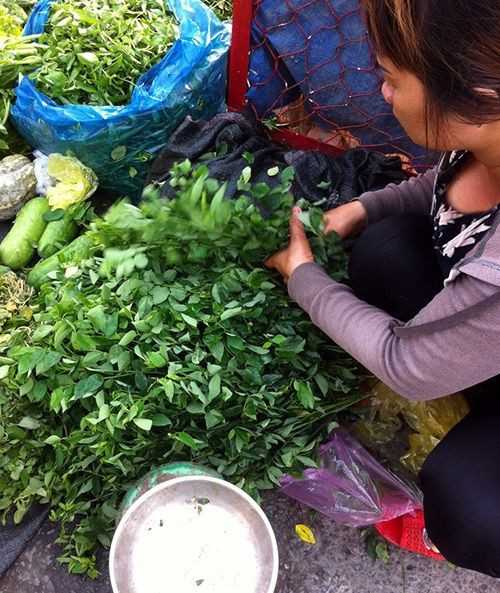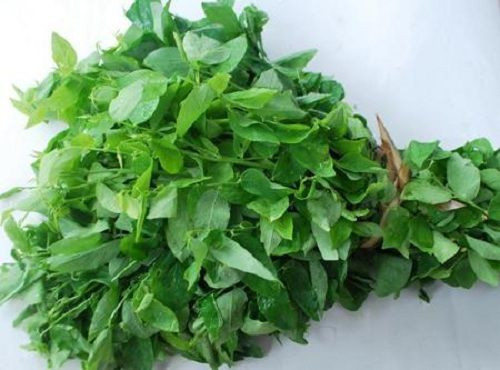Curly-leafed Malabar Spinach: A little-known danger
Because of fear that Malabar spinach is sprayed with a lot of pesticides and growth stimulants, many housewives whisper to each other, "When you go to the market, just choose curly-leaf Malabar spinach."
But in fact, not all curly-leafed spinach is clean.
Malabar spinach and bitter melon are almost green vegetables and foods grown and used year round.
Previously, only water spinach, bean sprouts, squash, cabbage, lettuce... were on the list of people's concerns, but now even Malabar spinach is "contaminated" with pesticides.
In fact, Malabar spinach is a very easy to grow plant, but during the growing process it is susceptible to some diseases that cause white aphids and striped dry spots.
Therefore, to grow Malabar spinach well and shorten the harvest time, growers do not hesitate to "bathe" Malabar spinach with pesticides and growth stimulants. Not to mention, many soil sources and water sources for growing Malabar spinach are heavily polluted.
According to experts, regular use of fruits and vegetables containing pesticide and chemical residues, typically Malabar spinach, can negatively affect consumers' health, such as: chronic poisoning, impact on the nervous system, etc.
According to the Knowledge newspaper, recently, at the gate of the market base 26 (Go Vap district, Ho Chi Minh City), plastic sheets were spread roughly on the road to arrange vegetables. In particular, every stall selling spinach has curly, thick, dark green leaves.
Ms. Pham Thi Hang (from Nam Dinh), owner of a spinach shop, offered: "My spinach has curly leaves and is this old, so it hasn't been sprayed with pesticides! I grow it at home in District 12, Binh Chanh District."
Inside the market at Base 26, there were also countless small, curly-leafed Malabar spinach plants. Every stall advertised genuine garden vegetables, 10,000 VND for just a few stalks of spinach.
Ms. Nguyen Ngoc Thuy (living at market base 26) complained: "Yesterday I cooked curly leaf spinach soup, also introduced it as homegrown vegetables, when finished cooking the soup was black, no one in the family dared to eat it."
 |
| Curly-leafed Malabar spinach is introduced as a genuine garden vegetable, 10,000 VND for only a few stalks of vegetable... (Photo: Knowledge) |
Associate Professor Dr. Huynh Thanh Hung, Head of the Department of Soil Chemistry, Ho Chi Minh City University of Agriculture and Forestry, said that do not think that curly-leaf spinach is not sprayed with pesticides.
Malabar spinach is an easy-to-grow plant with good disease resistance. However, during the growing process, some diseases attack, causing striped wilt and white aphids.
If properly applied with sustainable biological care techniques, without overusing chemicals, Malabar spinach is a plant that brings high nutritional and economic value. When the leaves are curled due to a virus, even if sprayed with chemicals to kill all the leafhoppers, the leaves will still curl.
On the other hand, over-spraying of pesticides also causes leaf curl.
Black spinach soup may be due to residual pesticides, excessive chemical fertilizers, unsanitary soil and irrigation water, or canal water contaminated with heavy metals such as lead, mercury, arsenic, manganese... which can all contaminate the leaves.
According to Associate Professor Dr. Huynh Thanh Hung, the criteria for determining safe vegetables are no pesticide residue, nitrate (due to high phosphate and nitrogen fertilization), heavy metals (due to irrigation sources and soil) and no microbial residue on vegetables.
However, vegetables containing heavy metals and pesticide residues cannot be detected by the naked eye. Nitrate residues can be recognized as thick, darker green leaves than normal. This type of vegetable is very sensitive to herbicides, and high concentrations can also cause the leaves to curl.
Ms. Nguyen Thi Hoa, in charge of the Plant Protection Service Station of Binh Thanh District, also said that there are strong concentrations of plant protection drugs in the form of oil emulsions. If sprayed in excess, they can make vegetable leaves harden and curl, making them look like old vegetables, deceiving users.
In addition, vegetable plants lacking certain trace elements also cause leaf curl, but it is a lighter curl than that caused by disease.
There are only a few pesticides that can be used for green vegetables that are indicated by a green or dark blue line under the bottle/package label. They have a short quarantine period, decompose quickly, and are less toxic, but the drug concentration is low so the effectiveness is not high.
The type of pesticide with a yellow line under the bottle label should not be used on green vegetables because it is too toxic, requires a long quarantine period, and leaves too much residual pesticide in the vegetables.
But in reality, vegetable growers use the types that are fast and effective, without realizing the harmful consequences to health.
Growers tend to increase the dosage, for example, 1 package of pesticide requires mixing with 8 liters of water, but only mixes 4 liters, or mixes many types of pesticides together to spray on vegetables, so the pesticides easily cancel each other out and cause overdose.
On the other hand, most gardeners use chemical fertilizers to speed up the harvest of vegetables and fruits, causing excess nitrate in vegetables.
"Once, we tested and found that many types of vegetables had nitrate levels hundreds of times higher than the allowable level. When eating a lot of vegetables with high nitrate content, an obvious symptom is difficulty breathing," said Ms. Nguyen Thi Hoa.
According to long-time vegetable farmers, spinach "bathed" in pesticides often looks quite nice with smooth green leaves, dark color, and large, long branches and leaves.
However, when stored in the refrigerator, after just one day the branches will lose all their leaves (even though the leaves are still fresh) and especially when cooking soup, if the spinach is dirty, the color of the soup will turn cloudy, slimy and scum will float around the sides of the pot.
If it is safe spinach, the green color of the leaves will be lighter, the branches and leaves will be smaller and the appearance will be bad: the leaves will grow unevenly, and some leaves will have soot (leaf borers).
 |
| Spraying pesticides at high concentrations can also cause Malabar spinach leaves to curl. (Illustration photo). |
How to choose safe, non-toxic spinach
Malabar spinach leaves:You should choose Malabar spinach with thin but hard leaves. Absolutely do not buy Malabar spinach leaves that are thick or soft, or leaves that are curled or abnormal. These may be Malabar spinach sprayed with pesticides.
Color:Good and clean Malabar spinach has bright green leaves, uneven leaves, and some leaves are damaged by insects. Meanwhile, you should avoid buying Malabar spinach with dark green leaves, leaves that are too young, even, and no leaves are damaged by insects.
Watermelon juiceWith fresh Malabar spinach, when cooked in soup, the water color is light green and clear, without any unusual color.
Meanwhile, if the spinach soup turns black or cloudy, has a lot of slime, and has scum floating around the pot, you absolutely should not eat it because it is spinach with residual pesticides.
Taste:When processed, Malabar spinach has its own distinctive flavor. If it has a strong, pungent taste mixed with a pungent smell, it means the Malabar spinach has been contaminated with toxic substances and should absolutely not be used.
Note:
According to many experts, the Malabar spinach season usually starts in July and lasts until March of the following year. To buy safe Malabar spinach, you should buy it in season and avoid buying it out of season.
You should buy Malabar spinach at reputable places such as: clean vegetable stores, supermarkets... Avoid buying at street stalls or sidewalks that do not ensure safety.
Malabar spinach needs to be washed many times with water, soaked in salt water for about 15 - 20 minutes to limit toxic substances before being processed as usual. Should be cooked thoroughly to limit the effects of Malabar spinach leaves containing toxic substances.
According to Alobacsi.vn






